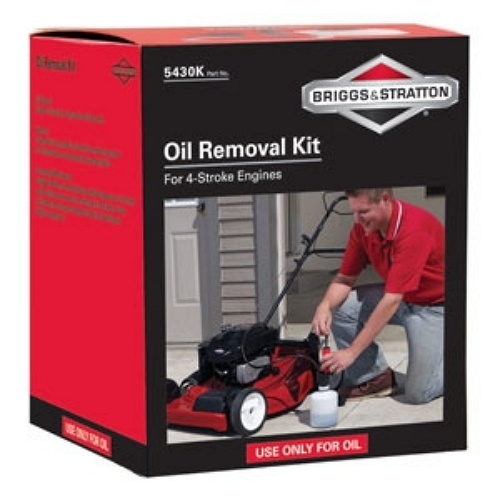Quick Links:
Before you are able to change the lawn mower oil on your Briggs & Stratton® small engine, it’s important to understand the oil type and capacity required. The type of equipment you use, the engine within, and the temperature outside determines what type of oil to use, how much you need and the cost of the oil. Use the Oil Finder tool below to find the right oil for you.
Different oil types can work best at certain temperatures. Learn which one to choose for your climate.
- SAE 30 - Warmer temperatures, most common oil for small engines.
- SAE 10W-30 - Varying temperature range, this grade of oil improves cold-weather starting, but may increase oil consumption.
- Synthetic SAE 5W-30 - Best protection at all temperatures as well as improved starting with less oil consumption.
- SAE 5W-30 - Very cold temperatures.
- Vanguard 15W-50 - Varying temperature range. For continuous-use, such as commercial lawn cutting or pressure washing.
When choosing lawn mower oil, use a high-quality detergent oil classified as "For Service SF, SG, SH, SJ" or higher. Do not use special additives.
Synthetic oils are an acceptable oil at all temperatures. The use of synthetic oil does not alter required oil change intervals.
Purchase the right oil for your engine at shop.briggsandstratton.com.

Walk-behind mowers:
- Oil capacity is typically 15oz or 18oz*.
- Check oil level during the season and add when necessary
- Change engine oil every 50 hours or annually, whichever comes first.
Riding mowers:
- Oil capacity is typically 48oz or 64 oz*.
- Change engine oil every 100 hours or annually, which ever comes first.

Yes! We have modified our engine oil recommendations to state that you may now use a synthetic 5W30 or 15W50 oil in all temperature ranges. We recommend the use of Briggs & Stratton Synthetic Oil. The use of this high-quality detergent oil assures compliance with Briggs & Stratton warranty requirements regarding the use of appropriate oil.
Engine break-in procedures using synthetic oil remain the same. Keep in mind that the use of synthetic oil does not prevent you from performing your regularly scheduled lawn mower maintenance (i.e. check oil, change oil, etc.).

- Park on level surface and remove the dipstick cap.
- Remove dipstick and wipe with a clean rag so reading will be accurate.
- Before reinstalling the dipstick, make sure the teeth on the cap match the grooves on the dipstick tube.
- Reinstall dipstick cap.
- Remove the cap again and view oil level towards the bottom of the dipstick blade.
- Oil level should be between the full and add marks.
- If oil level is low, pour a few ounces at a time to avoid overfilling.
- Allow enough time for the oil to settle before rechecking the oil level.
For a quick walkthrough on how to check and change your oil, see our How to Do a Small Engine Oil Change video.
Use the Oil Finder tool to help you find the best oil for your small engine. Choose your equipment, engine name (usually found on your engine label) and outside temperature that you will be using it in to find your recommended oil and how much to use.
If you need help determining if your riding mower's engine is a single cylinder or twin cylinder (V-Twin), click here.
Equipment:
Engine:
Outside Temperature Range
Shop Related Maintenance Parts
HOW-TO ARTICLES
Learn how to properly and safely use, troubleshoot and maintain your Briggs & Stratton equipment.
VIDEOS
Learn about the latest products, step-by-step instructions on how to locate your engine model number and more.





